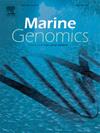Genomic analysis of Vibrio fluvialis QY27 related to its deep-sea environment adaptation
IF 1.5
4区 生物学
Q4 GENETICS & HEREDITY
引用次数: 0
Abstract
Vibrio fluvialis QY27, isolated from 2,500 m deep seawater in the South China Sea, was previously shown to tolerate high pressure via trimethylamine-N-oxide metabolism. However, the comprehensive adaptive mechanisms underlying its adaptation to the deep-sea environment remained poorly understood. To better understand its deep-sea adaptation, we conducted genomic and functional analyses. The complete genome comprises two circular chromosomes (4.78 Mb, 49.99 % GC), encoding 4,265 proteins, 108 tRNAs, and 31 rRNAs. Phylogenetically, QY27 shares 98.51 % ANI with V. fluvialis ATCC33809 and possesses a unique set of accessory and rare genes, reflecting significant genomic plasticity. Key adaptive features of QY27 is underpinned by key systems for essential resource acquisition: a multifaceted iron uptake system (vibriobactin, Feo, Efe), diverse terminal oxidases (bd, cbb₃, aa₃, bo₃) for aerobic flexibility, and integrated nitrogen metabolism pathways (TMAO respiration via torCAD/YZ and assimilatory nitrate reduction via napAB-nirBD). These integrated systems create a synergistic network, enabling QY27 to overcome high pressure, oxygen limitation, and nutrient scarcity in the deep sea. This study provides systematic insights into the metabolic adaptation of a non-piezophilic Vibrio fluvialis, advancing our understanding of microbial ecological adaptation and evolutionary in extreme environments.
与深海环境适应相关的河流弧菌QY27基因组分析
从中国南海2500米深的海水中分离出的河流弧菌QY27,先前被证明通过三甲胺- n -氧化物代谢耐受高压。然而,其适应深海环境的综合适应机制尚不清楚。为了更好地了解它对深海的适应,我们进行了基因组和功能分析。完整的基因组包括两条圆形染色体(4.78 Mb, 49.99% GC),编码4265个蛋白质,108个trna和31个rrna。在系统发育上,QY27与V. fluvialis ATCC33809具有98.51%的同源性,并且具有一组独特的附属基因和罕见基因,反映了显著的基因组可塑性。QY27的关键适应性特征是由必需资源获取的关键系统支持的:一个多面铁摄取系统(vibriobactin, Feo, Efe),多种终端氧化酶(bd, cbb₃,aa₃,bo₃)用于有氧柔韧性,以及集成的氮代谢途径(通过torCAD/YZ进行TMAO呼吸和通过napAB-nirBD进行同化性硝酸盐还原)。这些集成系统创建了一个协同网络,使QY27能够克服深海中的高压、氧气限制和营养匮乏。该研究为非嗜水性河流弧菌的代谢适应提供了系统的见解,促进了我们对极端环境下微生物生态适应和进化的理解。
本文章由计算机程序翻译,如有差异,请以英文原文为准。
求助全文
约1分钟内获得全文
求助全文
来源期刊

Marine genomics
生物-遗传学
CiteScore
3.60
自引率
5.30%
发文量
50
审稿时长
29 days
期刊介绍:
The journal publishes papers on all functional and evolutionary aspects of genes, chromatin, chromosomes and (meta)genomes of marine (and freshwater) organisms. It deals with new genome-enabled insights into the broader framework of environmental science. Topics within the scope of this journal include:
• Population genomics and ecology
• Evolutionary and developmental genomics
• Comparative genomics
• Metagenomics
• Environmental genomics
• Systems biology
More specific topics include: geographic and phylogenomic characterization of aquatic organisms, metabolic capacities and pathways of organisms and communities, biogeochemical cycles, genomics and integrative approaches applied to microbial ecology including (meta)transcriptomics and (meta)proteomics, tracking of infectious diseases, environmental stress, global climate change and ecosystem modelling.
 求助内容:
求助内容: 应助结果提醒方式:
应助结果提醒方式:


